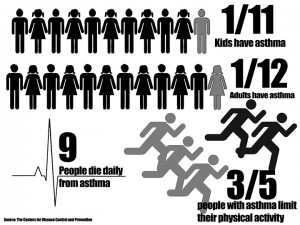As temperatures drop, some students could see their asthma conditions worsen as allergens and viral infections heighten during this season, according to Dr. Sharon Stern, medical director at the Baylor Health Center. Though most asthma is diagnosed during childhood and adolescence, college students are still prone to the condition without having been diagnosed in childhood.
“Asthma can present at any time during a person’s life,” Stern said. “It is fairly common in childhood and adolescence.”
Asthma is a medical condition that limits function of the lungs. The Centers for Disease Control and Prevention website states that asthma causes repeated episodes of wheezing, breathlessness and chest tightness. It often is associated with early morning or late-night coughing episodes.
Stern said many things can trigger asthma, and this is why college students are at risk.
“Asthma is defined as a reversible, episodic obstructive lung process,” Stern said. “There are two components of it: bronchial muscle spasm and inflammation. It may be triggered by cold air, exercise, allergies and viruses.”
Asthma attacks are usually treated in a multistep process. The first, the “rescue” phase, is used with an inhaler while the second phase, the “controller” phase, uses controller medication that relieves inflammation.
Stern said it takes one to two years for new allergens to develop ,so students new to Waco may not immediately notice any changes to their allergies.
“However, college students are prone to getting viral infections much more often due to the effect that poor sleeping habits and diet have on the immune system,” Stern said.
Students diagnosed with asthma should follow their asthma care plan.
“Always make sure to have a good supply of rescue inhalers that are not expired,” Stern said. Using a peak flow meter can help determine which medicines to take.”
Even students who were diagnosed as children but have not had symptoms recently should be prepared. Students can stay prepared by using a peak flow meter. A peak flow meter measures the function of one’s lungs by the output of oxygen, when blown into it.
“You don’t really outgrow it,” Stern said. “Your body just gets better at handling it. Once you have asthma, you always have it.”
Stern said family history can affect someone’s likelihood of getting asthma.
“People with a personal or family history of allergies or eczema or asthma are more likely to be diagnosed with asthma,” Stern said.
Angel Waldron, Asthma and Allergy Foundation of America spokeswoman, said the most common irritants for people with asthma include secondhand smoke, air pollution, perfumes and chemical odors. Students with a history of asthma should be aware of possible irritants in their surroundings.
Data collected in 2008 by the Center for Disease Control and Prevention shows that one in 12 adults have asthma. There were approximately 8.9 million doctors visits related to asthma that year.
The data also reported that asthma costs the nation close to $56 billion per year, and it affects an estimated 18.7 million adults and 7 million children in the United States. Texas also had one of the highest rates of asthma in adults ages 18-24.
Students concerned about asthma should consult a physician. Appointments can be made at the Baylor Health Center by visiting.baylor.edu/health_center or by calling the health center at 254-710-1010. Students can also call for 24-hour medical advice.







